Extra large Dogs
So you always had a thing for a big dog? Here are a few of the really large dogs, classified according to the guidelines of the American Kennel Club.
These dogs typically weigh more than 100 pounds and can put you back quite of bit when it comes to buying their food! Despite their size, these giants are usually content to nap on their favourite sofa for the most part of the day. It is, however, very important to properly socialize them and to give them the right amount of exercise. They make very good family pets, with the added bonus of a giant protector thrown in.
Anatolian Shepherd Dog
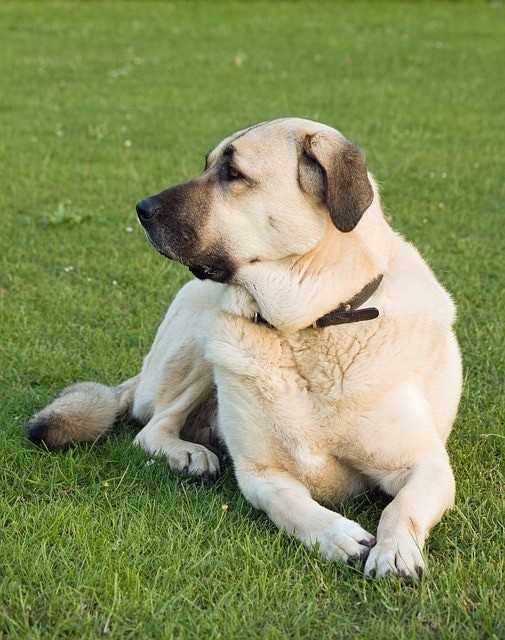
The Anatolian shepherd dog or Karabash is a reasonably independent, vigilant dog who is brave and can be dominant. In Turkey, where he originated, the dog is still used to protect livestock.
The Anatolian Shepherd Dog generally gets on well with other animals provided it has been introduced to them when young. They can be reserved towards strangers but there are seldom problems with children from their own family. They need quite considerable exercise and is not suited for a flat or maisonette.
They can be rather dominant towards other dogs. Much depends upon introducing the puppy early in its life to its own kind, other animals and people.
Bernese Mountain Dog
This is an equable, vigilant and friendly dog who is very loyal to its family. It is attentive, calm, intelligent and seldom barks. The dog is a quick and eager learner who is very responsive.
The Bernese Mountain dog are normally wonderful with children. Provided they have met cats and other household animals as young dogs, they behave properly towards them. They are very good watchdogs but will never pace your garden fence barking. The dog need lots of exercise and need to be taken out regularly.

Boerboel
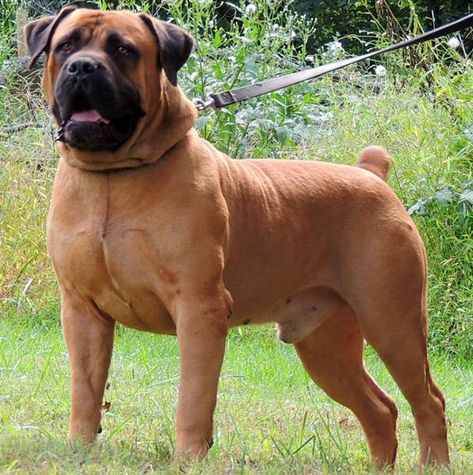
The Boerboel is a protective, loyal, strong, courageous dog. They are obedient, intelligent, confident, and dominant dogs. The Boerboel is a South African dog which were bred to protect the homestead. They are one of the most powerful dogs in the world.
The Boerboel should be trained and socialized when young, otherwise they can become dominant towards other dogs. The Boerboel love their family, which includes the children of the family. They should however be watched, as they can accidentally hurt young children just because they are so big. The Boerboel can also act a bit overprotective at times.
The Boerboel are so fearless and loyal that they would fight to the death to protect their family. Friends and other visitors should be properly introduced to the dog. They make very good watch dogs.
Bullmastiff
The Bullmastiff originated from a cross between bulldogs and mastiffs and is native to Great Britain. Here it was primarily used as help for gamekeepers while on patrol against poachers.
The Bullmastiff is massive and heavily built without appearing clumsy. Despite its size, it is surprisingly good-natured. They are very tolerant towards children but can be rather dominant towards their own kind. If socialized when very young, they get on well with other household pets. They will accept friends and family, but will not tolerate unwanted visitors.
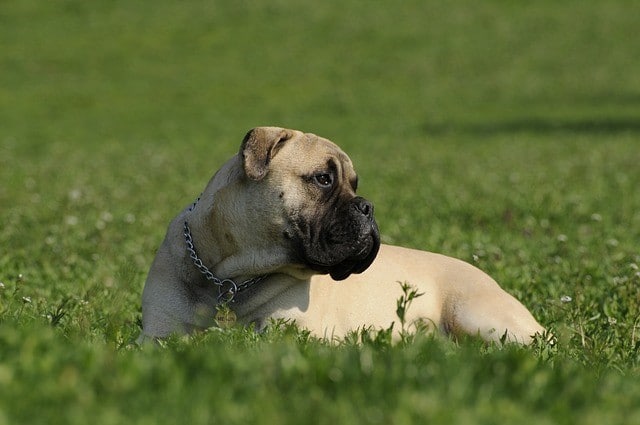
Caucasian Shepherd Dog

The Caucasian shepherd dog or Owtcharka was originally bred to protect livestock from predators. This is a very brave, vigilant and strong dog who will distrust people it does not know. It has a very powerful urge to protect. It will protect anything that belongs to the family, be that children or other pets. You should therefor not leave the dog alone with children, as it will try to protect them if they play too rough!
The log-haired kind will require grooming with a brush and comb from time to time. They need moderate exercise and is best suited for a family with lots of space. Because of its thick coat, it can happily be left outdoors.
Dogue de Bordeaux
The Dogue de Bordeaux is fairly rare, even in its home country (France). They are considered to be rather sulky and moody in temperament. The dog becomes rather attached to its owner and wants to please him/her and requires somebody who has command over it.
When the Bordeaux has lots of positive experiences in its youth, enabling it to develop into an equable dog, its behavior with other pets will probably be fine. They are usually kind and protective of children, but visitors are regarded with suspicion. They can be rather dominant towards other dogs.

Great Dane

It is said that a housebreaker can easily get into a house guarded by a Great Dane, but can never get out!
These affectionate, calm and intelligent dogs are sensible, sensitive and very loyal to its family. Despite the fact that they do not bark often, they make excellent watch dogs.
Fast growing breeds like the Great Dane require special care during the growing stage. It is firstly important to give the right nutrition. Furthermore exercise should be limited, while avoiding pressurizing and limiting over-tiring, as this can cause serious problems for the development of bones, joints and muscles.
Generally Great Danes get on very well with their own kind, other household pets and children. Most of them are rather uncertain of strangers, but friends of the family will be warmly greeted.
Irish Wolfhound
The Irish wolfhound is the largest breed in the world. A fully grown dogs stands on average 32 – 34 inches at the shoulder. With its great size, impressive bulk and rough grey coat, it would seem that the wolfhound has everything needed to make it the ideal, awe-inspiring guard. Its threatening presence is, however, softened by its gentle, dark eyes and an affectionate, friendly disposition.
The Irish wolfhound gets on well with children and there should be no difficulty with other dogs. This is also true for other animals if the dog gets to know them when it was young. The Irish wolfhound is relatively easy to train. These dogs grow rapidly, so do not forget to teach it not to pull on its lead before it gets too big and strong! They need high-quality food while growing; while forced exercise are too taxing for their bodies. It take two whole years before they are fully grown.

Leonberger
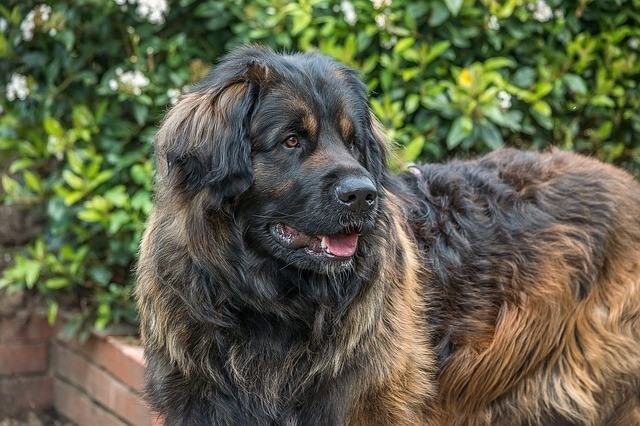
The Leonberger is a German breed which has appeared during the last century through crosses between the St Bernard, black and white Newfoundland and the Pyrenean mountain dog.
This is a peaceful, self-confident and equable dog which is straight-forward, loyal, intelligent, a quick learner and will alert you to visitors. The Leonberger gets on well with other dogs and other household pets, and mixing with children present no problems. It makes little difference to them whether visitors have evil intentions or not. Once it has alerted you, the Leonberger considers its job done!
Mastiff
The Mastiff is a calm, self-confident, watchful, patient dog. They are soft-natured towards their family, intelligent and dignified. It rarely barks but it is in its nature to defend its territory and its family against wrongdoers.
Provided they are correctly socialized, the Mastiff presents no problems mixing with other dogs and household pets. Normally its behaviour with children is good-tempered and friendly. When strangers visit, it determinedly refuses them access unless they are accepted by its owner.
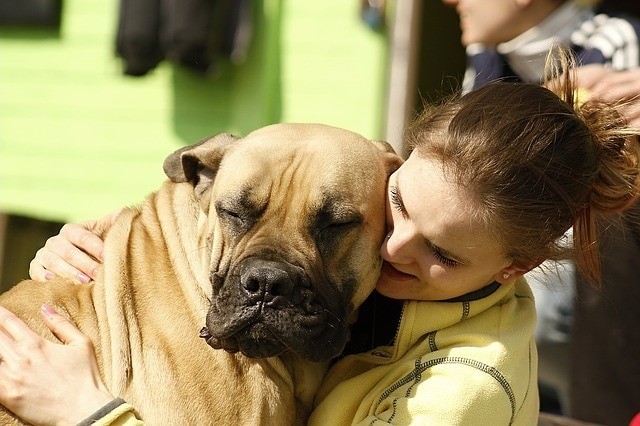
Newfoundland
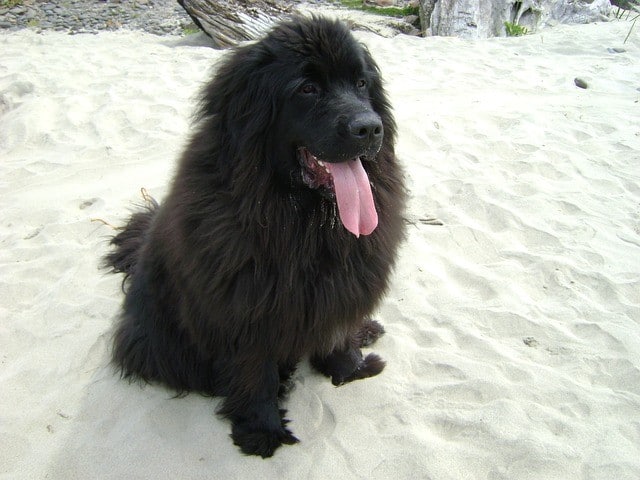
Saint Bernard
The Saint Bernard is good-humoured, friendly and equable. The St Bernard is marvelous with children, loyal to its owner, careful and not given to barking. It will defend you and your possessions if necessary although this is not its primary role.
Young dogs must be taught early not to pull on the lead because this will be hard to teach them later. In common with all mastiff types, the St Bernard requires considerable understanding in its training from you. Ensure also that they are not too physically stretched in the growing stage.
St Bernards get along fine with children, and other dogs and household animals normally present no problems.

image sources
- Boerboel: test image source | CC BY-NC-SA 4.0 International
